Contents
Introduction
The White Conduit Fields Ground played a major part in cricket history, even though only staged one first class match and 13 other known important matches. Its significance arises from the fact that it was home to the team of the sporting aristos of the Star and Garter Club who were soon to move to the Dorset Square Lord’s Ground and form the MCC. It was, in many respects, the predecessor of Lord’s.
It is however, a ground about which very little has been written. So let’s start at the beginning.
History of White Conduit Fields and Leisure Gardens
The White Conduit itself was built in 1431 under royal license to supply the Charterhouse (a Carthusian Monastery), in Clerkenwell. with water. A source of water was found at Islington and a pipe (called a conduit) was constructed to bring fresh water to the Monastery. Because the White Conduit was at a higher level than the Charterhouse, the water traveled through the pipe by gravity. At a later time, the lead cistern holding the head of water at Islington was arched with brick and flint, with a loft above, and enclosed in a small white building. It was restored in 1641. By 1654, the supply of water was found to be so reduced that it was abandoned and water from the New River (in fact a canal) was used instead. The map below is from 1750, the bright red marker, centre right, is around the area of the conduit head, and later, White Conduit House.
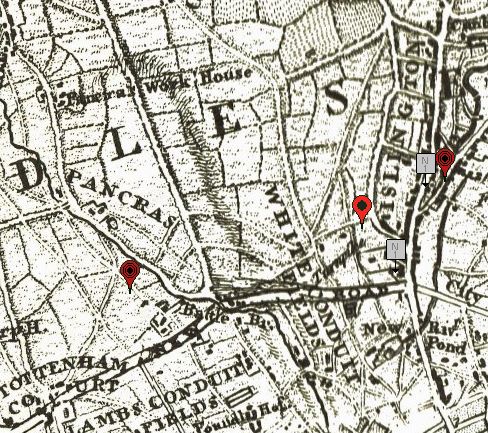
From the late 17th century, the site was developed as pleasure gardens away from the city centre, particularly favoured by the less well-off. In the eighteenth Century a large tea-room was build to take advantage of the crowds of Londoners who would journey there to take advantage of the fresh air and open landscape to the North.
Here are three illustrations which show how the facility developed. The years given are 1731, 1749 and 1831.

Note the small building with steeply sloping roof in each illustration (in dilapidated state in the 1831 illustration) – that is the conduit head.

This small plan of the House and gardens, taken from a 1805 map of Islington based in a survey of 1793, shows that there were formal gardens to the East of the House. Note the rounded end of the building by the letter H – no other building shows this feature, I suggest it is the rounded end of the tea rooms.
A Map of the area from 1750 shows a considerable strip of land, to the West of the House and running from South to North, which is labelled as White Conduit Fields.
The cricket ground
Early in the Eighteenth Century, White Conduit Field established itself as a place where cricket could be played. It appears to have been a facility available to be hired by whoever wanted to play, be they great or otherwise, and several; significant matches took place there. Cricket Archive lists some fourteen matches of importance at this ground, covering three periods. Firstly, nine matches in the period 1718-1732, one each in 1772 and 1773 and four in the period 1784-1786. These are listed below; it should be remembered that there would have been many other matches as the field was available for hire, these were ones where the scores have been preserved and are between representative sides. They only give a glimpse of the importance of this facility.
| 1 | July 1719 | London | Rochester Punch Club |
| 2 | 19 Aug 1719 | London | Kent |
| 3 | 09 Jul 1720 | London | Kent |
| 4 | 18 Jul 1722 | London | Dartford |
| 5 | 10 Aug 1724 | Dartford | Penshurst |
| 6 | 05 Aug 1728 | Middlesex | London |
| 7 | 12 Aug 1730 | London | Kent |
| 8 | 07 Aug 1732 | Middlesex | London |
| 9 | 05 Aug 1773 | London | England |
| 10 | 22 May 1784 | not known | not known |
| 11 | 27 May 1784 | not known | not known |
| 12 | 30 Jun 1785 | White Conduit Club | Gentlemen of Kent |
| 13 | 22 Jun 1786 | White Conduit Club | Kent |
There are clearly two phases to the grounds use, separated by over forty years. The early part of the Eighteenth Century saw it as a occasional home of the important London Cricket Club. The first move away from this ground may be attributed to the rise of the Honourable Artillery Company Ground from 1730 onwards, soon established as the centre of the cricket world, eventually to be overtaken by the Hambledon period, around 1770. Cricket however continued to be available as a recreation at this location as this 1754 advertisement makes clear:
This is to acquaint the public that at the White Conduit House the proprietor, for the better accommodation of gentlemen and ladies, has completed a long walk with a handsome circular fishpond, a number of shady pleasant arbours, inclosed with a fence seven feet high to prevent being in the least incommoded from the people in the fields. Hot loaves and butter every day; milk directly from the cows; coffee and tea and all manner of liquors in the greatest perfection; also a handsome long room, from whence is the most copious prospect and airy situation of any now in vogue. I humbly hope the continuance of my friends’ favours, as I make it my chief study to have the best accommodations, and am, Gentlemen and &c., your obliged humble servant, ROBERT BARTHOLOMEW.
Note. My cows eat no grains, neither any adulteration in the milk or cream. Bats and balls for cricket, and a convenient field to play in.
The Daily Advertiser for August 10th, 1754
After the Hambledon period started to wind down, around 1780, there was a move to re-establish cricket in London, a move centred at the Star and Garter Tavern in Pall Mall resulting the formation of a team of gentlemen to play at the ground and known as The White Conduit Club from at least 1782. It is quite possible that the ground used was not precisely the same one as the fields that were used in the earlier part of the century. Perhaps indeed, the 1754 advertisement announced the establishment of a new field? More of that later.
The new field however, if that it was, did not work out for its aristocratic players. There was much dissatisfaction with the lack of privacy and this precipitated a relocation to Dorset Square, in Marylebone, organised by one of the White Conduit Club players called Thomas Lord, and this itself led to the foundation of a new club – The Marylebone Cricket Club. The White Conduit Fields ground however continued to be used for matches of the Albion Cricket Club until around 1834. After that it was built over.
Illustrations
There are no less than five illustrations of Cricket of this ground, plus others which are reproductions of these. It is important to note that all come from the later period of the ground’s main use. These are shown below
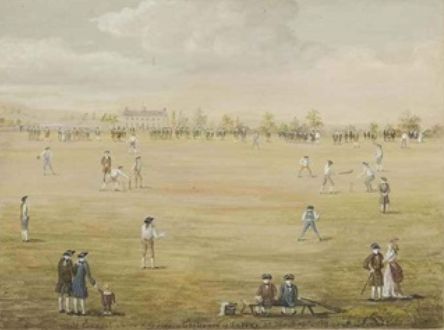
1780s – Cricket match at White Conduit Fields
A South to North view. The large building in the background is the Islington Workhouse.
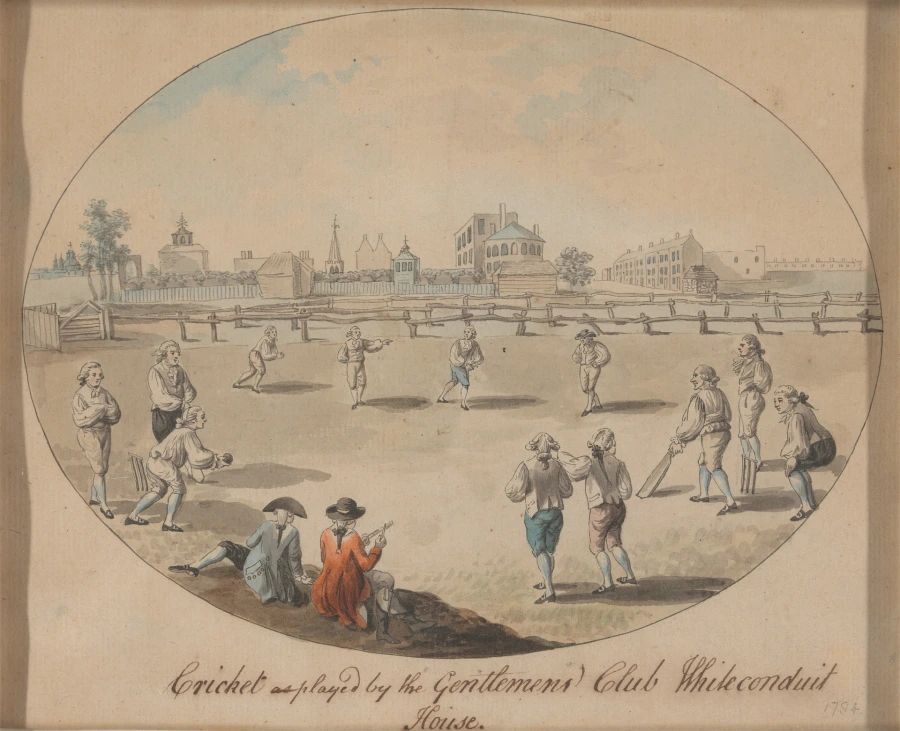
1784 -The Gentlemen’s Club playing on White Conduit Fields – Robert Dighton.
This view of White Conduit Field is from the North to the South – the City of London skyline is prominent. An unusual example of a painting with several identifiable topographic details beyond the field itself. White Conduit House and Grounds were an important 18th Century leisure facility for the less well-off classes. The site of the central building is now on Penton Street, Islington.
This illustration is taken from a series of prints of activities at White Conduit Fields by Robert Dighton, and dated around 1784. The rounded building in the background is clearly the same one as that above dated 1831, in fact a tea room for the general public. I suggest that the 1831 picture above is from a North West viewpoint, whereas this one is nearer to due North, looking South. The Conduit Head is visible, to the right, in front of the terraced housing (Fenton Street). Behind the fence on the left are are the formal gardens and beyond it, the skyline of the City of London.
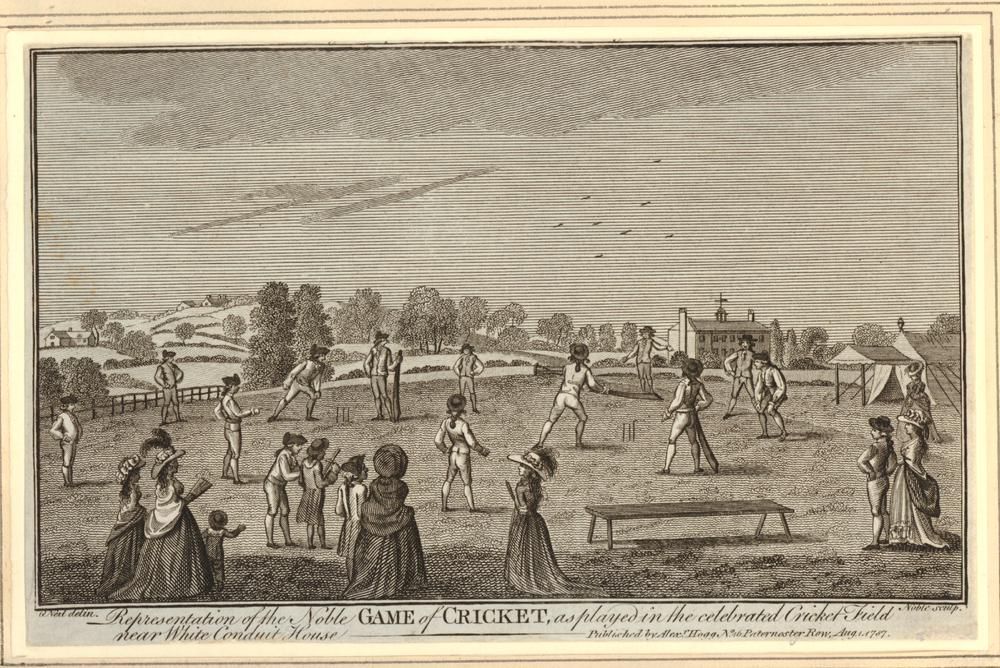
1784 – Cricket at White Conduit Fields – engraving
This is a view from South to North, away from the White Conduit building. The large building in the background is the Islington Workhouse. The small hill in the background is reminiscent of the one in the 1731 the view above (very likely, Highgate).
Observe the enormous bats, nearly shoulder height! The low three-stump wicket however, was never a feature of the game.
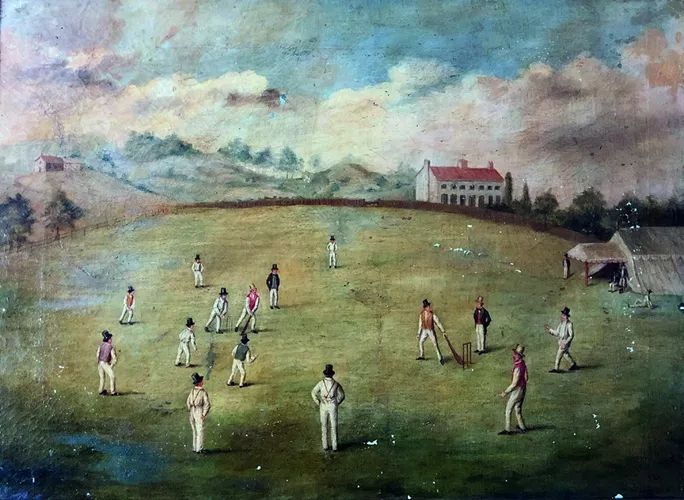
1790 – Cricket at White Conduit Fields – painting
A view, very likely based on the engraving of 1784. Note the similarity of the presentation of background features such as the cottage (left), the tent and the workhouse.
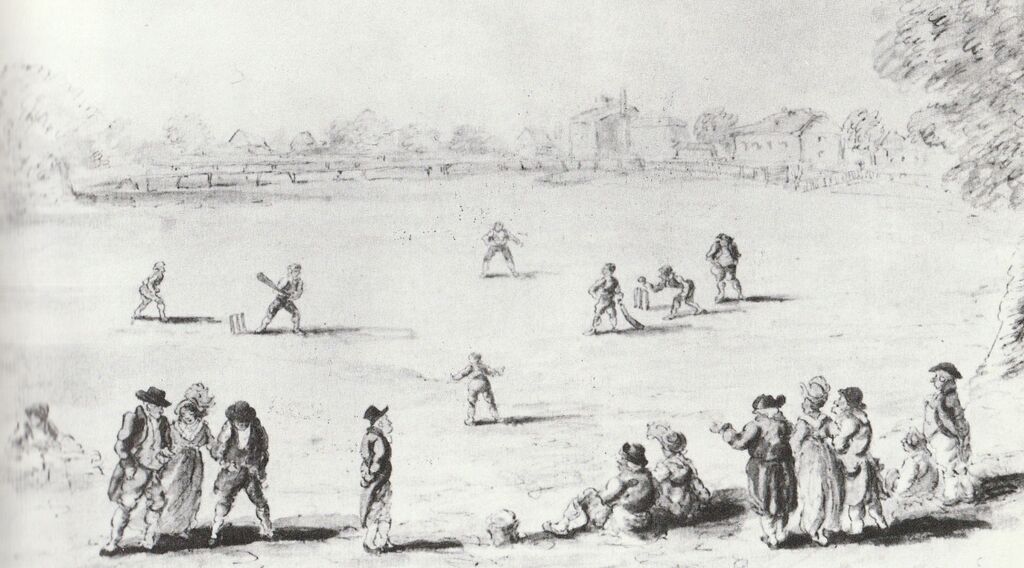
1790 – Cricket at White Conduit Fields – Thomas Rowlinson
A view, very likely, based to some extenton the engraving of 1784 by Robert Dighton, although there are several differences, for example bowling is from the opposite end. However, the White Conduit buildings are fairly clear in the background. This picture though, has the element of friendly caricature.
Location
Since these days, White Conduit Fields has disappeared under Islington development and White Conduit House has been demolished. Can we however, identify exactly where the cricket field was?
One thing we do know about is where White Conduit House was. It was replaced by a tavern in the mid 19th Century which is still there, now known as the Little Georgia Restaurant, selling Georgian food (the country, not the period). It is at 14 Barnsbury Road on, the corner between Dewsby Road and Barnsbury Road; there is a frieze on both fronts inscribed with sunk lettering saying ‘WHITE CONDUIT HOUSE’. The location confirms closely with maps which show where the old White Conduit House was so we can rely on this identification.

Rather pleasingly, there is a community garden area east of the pub, called Culpeper Community Garden, where there used to be formal gardens, so a little of the old use is preserved. The cricket ground is not so easy to pin down. Many authorities assume that is was close to the House, maybe immediately west, as it appears that this is where the leisure fields associated with the House were located. Perhaps this was the case for the earlier matches, it is very hard to track down any strong evidence.
A point to make though is that in the early days of cricket, grounds would not always be formally laid out on a permanent basis the way they are today. Matches would often be played in large fields, with the result that the ground would have being placed wherever seemed a good idea on the day. In particular, as I say above, there is no reason to believe that the games of the earlier period were played in the same place as those of the later period. The 1754 advertisement does suggest however that a specific field has been established by that date, one which was convenient for rather that adjacent to the main house.
There are I suggest five pieces of evidence which suggest that the later games at least, were at a more northern location.
Firstly and perhaps most importantly, there is the map of Islington of 1805 referred to above and shown in more detail below:
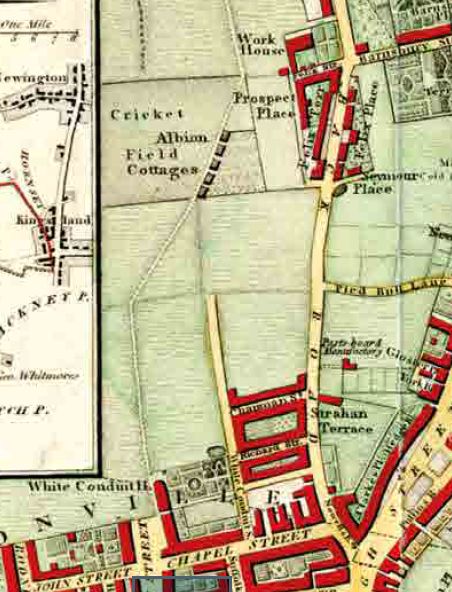
Here we see an area, well to the north of the house marked as a cricket field. Nearby is Prospect Place and very close to the ground are Albion Cottages. Note these cottages are not shown on other versions of the map and the caption describing them is somewhat clumsily placed, so I think they are a later addition. Alongside them, there is clearly a path across the field.
What is surprising is the distance from White Conduit House – just short of half a mile. It is though within the boundaries of White Conduit Fields as shown on the 1750 map.
Secondly, again very important, is the text below, extracted from a book snappily entitled Walks through Islington; comprising an historical and descriptive account of that … district, both in its ancient and present state … With numerous engravings, by T. Cromwell, J. & H. S. Storer. L.P., published in 1835.
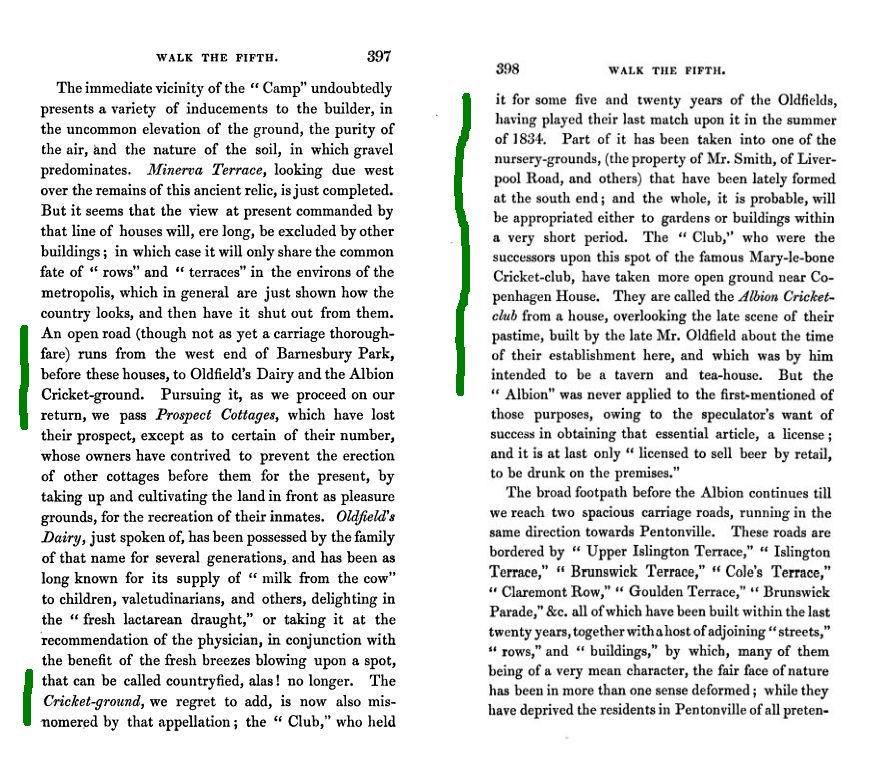
This tells us quite a lot about the cricket ground. The uses of the names Albion and Prospect confirm that we are looking at the same field as is marked on the Islington Map. Importantly, the text also confirms that the players who went on to form the MCC actually played here.
Thirdly, Storer refers to a tavern called The Albion close to the ground and, yes, there is still a pub called the The Albion, at the edge of where the cricket field would have been and dating back to the 18th Century. A very good pub too, which features an impressively faithful Georgian restoration showcasing the place’s rickety floors, wood-paneled walls and log fires. Good food too.
Fourthly, a report in The Times of 22 June 1785 referred to complaint made by players of the White Conduit Club that people were interrupting their games by using a footpath across the playing area. There is indeed such a path shown on the 1805 map.
Fifthly, the first, third and fourth illustrations above shows the Islington Workhouse as being close to the ground on the North-East side, precisely where the map of Islington places it.
So where does this place this ground in the modern world of Islington? The up-to-date map below gives the answer, as best as I able to calculate it. The green square is the Albion pub, The Blue square is where I believe the original ground was and the red square is where the original White Conduit House was and the Little Georgia restaurant is today. If this is correct, then there is a green space on part of the site of the ground, now known as Thornhill Road Gardens, a lovely area looked after by a community project established by the Friends of Thornhill Gardens in 2019.
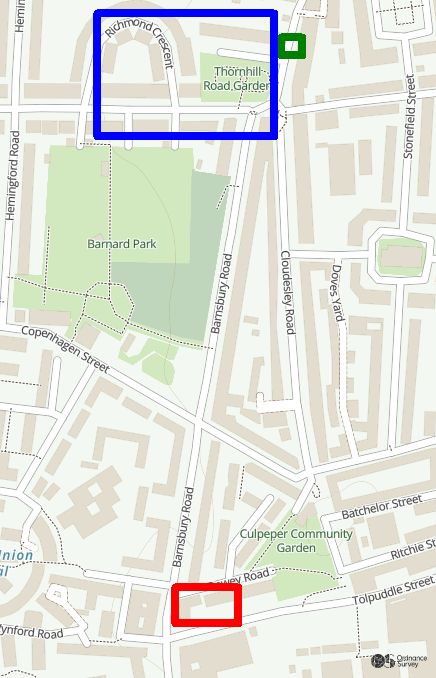
But how does this fit with the illustrations of the cricket grounds shown above and the backgrounds? The first, third and fourth illustrations seem to fit well. As regards the second illustration, the one facing South and showing showing the White Conduit building just beyond the boundary, I can only suggest that artistic license was involved. A view from the ground, would have included a view of the house in the middle-distance, and indeed the London skyline beyond. I believe that the artist has moved them all closer together to make the picture more interesting. This is particularity likely as the painting is one of a series seeking to promote White Conduit House as a leisure and sporting venue.
Incidentally, Richmond Crescent, within the blue square, was the home of former Prime Minister, Sir Tony Blair.
The probable site of the ground, as it is today

White Conduit House and Cricket in Eighteenth Century Islington:
an exhibition compiled by James Dunnett 2012
In August 2023 I received a copy of the document reproduced below – it provides excellent coverage of the topics discussed above together with some more detail on White Conduit House itself. Happily it supports my own independent conclusion.
James Dunnett has kindly given permission to reproduce his work. He continues to assert his rights under the Copyright, Designs and Patents Act 1988.
